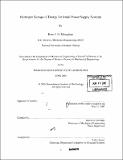Hydrogen storage of energy for small power supply systems
Author(s)
Monaghan, Rory F. D. (Rory Francis Desmond)
DownloadFull printable version (9.462Mb)
Other Contributors
Massachusetts Institute of Technology. Dept. of Mechanical Engineering.
Advisor
Ernest G. Cravalho.
Terms of use
Metadata
Show full item recordAbstract
Power supply systems for cell phone base stations using hydrogen energy storage, fuel cells or hydrogen-burning generators, and a backup generator could offer an improvement over current power supply systems. Two categories of hydrogen-based power systems were analyzed: Wind-hydrogen systems and peak-shaving hydrogen systems. Modeling of base station requirements and alternative power supply system performance was carried out using MATLAB. Final results for potential alternative systems were compared to those for the current power systems. In the case of the wind- hydrogen systems, results were also compared to those of a wind-battery system. Overall feasibility was judged primarily on the net present cost of the power supply systems. Other considerations included conformity to present regulations. Sensitivity analysis of the wind-hydrogen model was carried out to identify the controlling variables. Numerous parameters were varied over realistic ranges. Important parameters were found to include wind resource, electrolyzer size, distance from electricity grid, price of diesel fuel, and electrolyzer and fuel cell cost. The model verified cell phone industry figures regarding the geographical conditions favorable to diesel genset use. Final results for wind-hydrogen systems suggest that for today's electrolyzer and fuel cell costs, wind-battery-diesel systems are the most suitable power system more than 8km from the existing electricity grid, with an annual average wind speed of 7m/s or more, and where diesel costs more than $2.20/gallon. (cont.) Thinking to the future, with 20% reduced electrolyzer and fuel cell costs, a wind-fuel cell-diesel system with a 15kW electrolyzer is the most suitable system at locations greater than 8km from the existing electricity grid with an annual average wind speed of 7rn/s or more and total diesel costs greater than $2/gallon. Within 8km the grid, in all cases, grid connection is most suitable. Outside this range, with diesel prices below $2/gallon, a genset only system is most suitable in most cases. Analysis of the peak-shaving hydrogen system suggests that it is not suitable for deployment under any realistic circumstances. Replenishment of hydrogen stores has a substantial power requirement.
Description
Thesis (S.M.)--Massachusetts Institute of Technology, Dept. of Mechanical Engineering, 2005. Includes bibliographical references (p. 91-92).
Date issued
2005Department
Massachusetts Institute of Technology. Department of Mechanical EngineeringPublisher
Massachusetts Institute of Technology
Keywords
Mechanical Engineering.